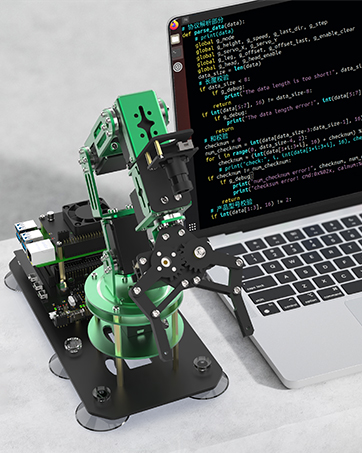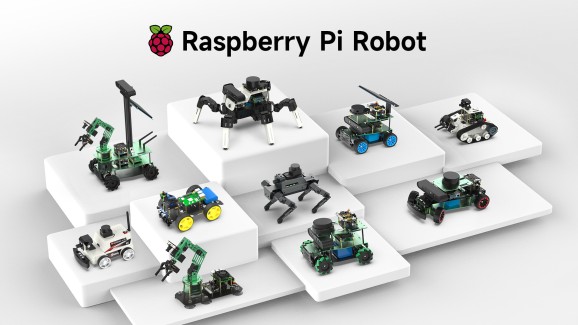In 2019, Raspberry Pi 4B appeared in the developers' field of vision. Its excellent performance immediately triggered a boom in Raspberry Pi development, and people's expectations for Raspberry Pi 5 are rising. But for Raspberry Pi enthusiasts, the wait for the update iteration this time is really a bit long.
In order to bring more high-quality robot kits to artificial intelligence enthusiasts, Yahboom has fully completed the layout of Raspberry Pi robot products, from easy to difficult, from wheeled robots to hexapod robots, from bionic robotic hands to AI robotic arms. The comprehensive product matrix brings users a huge choice space. We always hope to help more artificial intelligence enthusiasts find the robot that suits them!
In 2024, the fifth generation Raspberry Pi is finally officially launched! The new Raspberry Pi 5 is more powerful in terms of processor performance. Yahboom's entire Raspberry Pi product line will also undergo a strong upgrade. The course materials are fully compatible with the Raspberry Pi 5. This has made many developers look forward to it. Come first.
Let’s take a look at the improvements of Raspberry Pi 5 compared to Raspberry Pi 4.
1.CPU upgraded to BCM2712 Cortex-A76x4 @2.4GHz, 16nm process
The CPU has been fully upgraded, and the performance has been greatly improved. The Raspberry Pi 5 also uses 32-bit LPDDR4X, with an operating frequency of 4267MT/s, which is higher than the 2000MT/s on the Raspberry Pi 4.
2.GPU upgraded to VideoCore VII, supports OpenGL ES 3.1, Vulkan 1.2
The updated VideoCore hardware video scaler (HVS) can drive two 4Kp60 HDMI displays simultaneously, an improvement over the single 4Kp60 or dual 4Kp30 on the Raspberry Pi 4.
3.Added RP1 "southbridge" southbridge chip designed by PICO team
All input and output of the Raspberry Pi 5 except for the SD card and HDMI are completed using the RP1 IO controller. The USB bandwidth provided by RP1 is more than twice that of previous models, which allows the two USB 3.0 ports to support a rate of 5Gbps at the same time.
4.Newly added components: Renesas DA9109 power management chip
Adds power consumption measurement function, USB-PD power supply support, and PC-style power switch to Raspberry Pi 5.
In summary, compared to Raspberry Pi 4, the CPU performance of Raspberry Pi 5 has been greatly improved, and it has smoother video images and greater storage bandwidth.
① Powerful main control performance, the computing power is 2-3 times higher than Raspberry Pi 4
Raspberry Pi 5 uses the new 16nm BCM2712 chip, whose core is the Cortex-A76x4 @2.4GHz processor. Cortex-A76 is three generations ahead of the Cortex-A72 used in Raspberry Pi 4 in microarchitecture, that is, it can execute more instructions per clock cycle and consume less power per instruction.
The combination of a more powerful core (Cortex-A76), a higher clock frequency (2.4GHz) and a smaller process size (16nm) has increased the computing power of Raspberry Pi 5 by 2-3 times compared to its predecessor.
②The expansion board is fully upgraded to support the Raspberry Pi 5 power supply protocol
The high performance of Raspberry Pi 5 places higher demands on the power supply system.
lf other power supply solutions are used to Raspberry Pi 5, the USB current output will be limited to 0.6A, and there may even be low woltage/curent limit warnings,causing the device to restart frequently.
Therefore,Yanboom chose power expansion boards designed specfially for Raspberry Pi 5, integrate the PD protocol and can provide a stable 5V/5A output
Such as Yahboom power expansion board for Pi 5/ROS robot expansion board/microROS robot expansion board


③ Support main control replacement and upgrade, ROS2 development
All ROS robots in the Yahboom Raspberry Pi series have been upgraded to ROS2. Compared with ROS1, ROS2 has significantly improved communication mechanisms, multi-machine coordination, real-time performance, etc., and the robots will have more superior performance.
④ The frame rate of the recognition screen is increased, and the visual algorithm runs more smoothly
Through testing using visual algorithms such as Yolov5 and MediaPipe, when using the same camera and resolution settings, the recognition screen returned by Raspberry Pi 5 is about 50 to 100% higher in frame rate than that of Raspberry Pi 4. Smoother images allow robots to achieve faster recognition speed and higher accuracy when using vision algorithms to perform tasks.
1.MicroROS-Pi5 Robot

MicroROS-Pi5 is a ROS2 robot developed based on Raspberry Pi 5, with a 2-DOF camera PTZ and TOF lidar, built-in OpenCV image processing and MediaPipe machine learning algorithms, which can realize robot motion control, AI visual interaction, SLAM mapping navigation, multi-machine synchronous control. We provides a new Raspberry Pi 5 power supply solution, which can provide 5.1V/5A power supply.
2.Transbot SE

TRANSBOT-SE is a tracked robot developed based on the ROS system. Equipped with a 3-DOF robotic arm and a 2-DOF camera PTZ. It is compatible with the Raspberry Pi 5 and built-in OpenCV image processing algorithms, MediaPipe machine learning, AI deep learning framework, and movelt simulation platform. It can realize robotic arm handling, AI recognition, tracking, autonomous driving, robotic arm simulation control.
3.ROSMASTER Series (X3\X3 PLUS\X1\R2) Robot
The ROSMASTER series is equipped with a ROS robot control board, which is fully compatible with the Raspberry Pi 5 and can provide a stable 5V/5A power supply for the Raspberry Pi 5, effectively avoiding abnormal situations such as freezing and restarting. With a variety of lidar and camera, as well as voice interaction modules for choice. The biggest difference between the ROSMASTER series is mainly in ROS support and structure.
4.DOFBOT Robotic arm

DOFBOTAI visual robotic arm uses Raspberry Pi 5 as core controller, OpenCV as image processing library, JupyterLab as development tool, and Python as main programming language. The integrated design of camera and robotic arm can not only realize color recognition and grabbing, but also perform garbage classificatio. Through ROS robot control system, the complex motion control of 6-DOF serial bus servo is simplified.
5.DOGZILLA Robot dog

DOGZILLA is a 12 DOF desktop AI robot dog, which can feedback its own posture and joint angle and torque. The coprocessor combines the inverse kinematics algorithm to support a variety of motion gaits. Using Raspberry Pi 5, supports Python programming and ROS2 system, and can realize machine vision, robot kinematics, gait control, lidar mapping navigation, voice control.
6.Muto Hexapod robot

Muto RS is an 18-DOF bionic hexapod robot based on the ROS2 system, adopt Raspberry Pi 5 master control. Equipped with intelligent bus servo, lidar, depth camera, voice interaction module, and Raspberry Pi 5 power expansion board. It can realize robot motion control, Al visual interaction, map navigation, docker container development, deep visual tracking, voice interaction and other applications.


